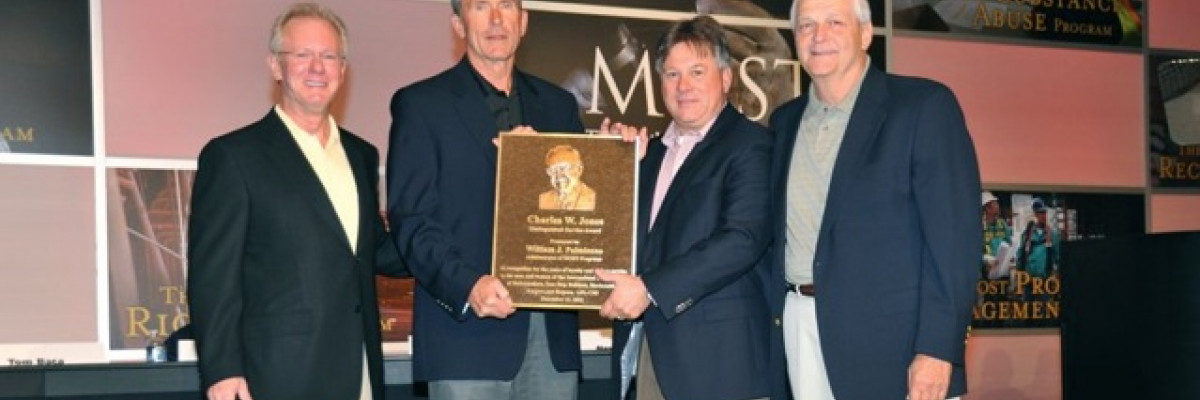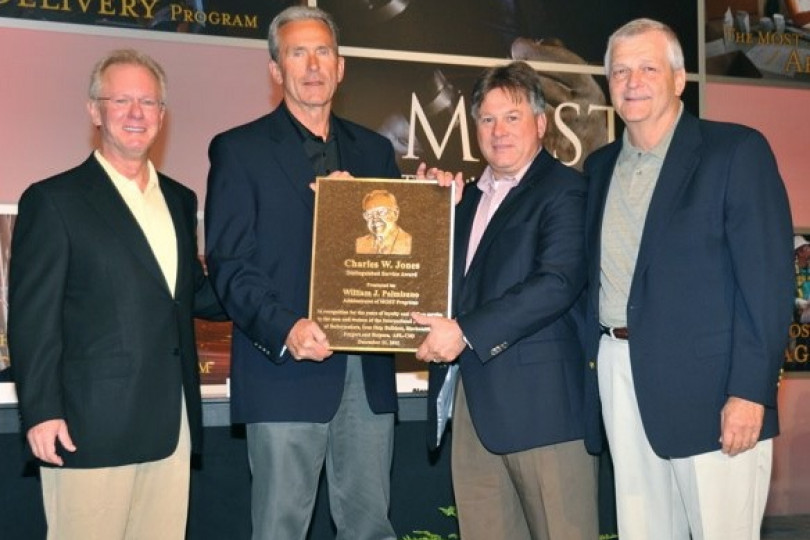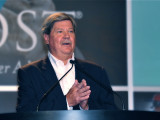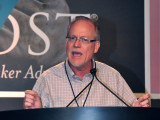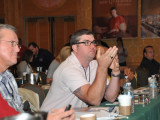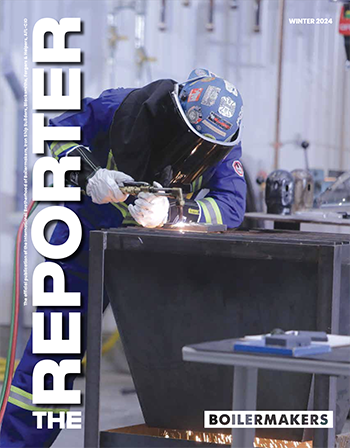MOST ADMINISTRATOR BILL PALMISANO, r., receives the Charles W. Jones Distinguished Service Award. L. to r., IP Newton Jones, IVP Larry McManamon, and IVP Dave Haggerty.
View Photo Gallery (6 photos)
Alliance salutes retiring MOST administrator
THE 26TH ANNUAL MOST Tripartite Conference held at Myrtle Beach, S.C. Oct. 2-6 examined a host of industry developments, with an emphasis on pending U.S. Environmental Protection Agency (EPA) regulations and their impact on coal-fired power plants. But before addressing those developments, participants took time to acknowledge long-time MOST Administrator Bill Palmisano, who will retire at the end of the year.
International President Newton B. Jones paid tribute to Palmisano, stating: “While MOST was conceived and initiated by our late leader, Charles W. Jones, he knew he needed someone special, someone willing to dedicate his every effort to shepherd the success of his unique insight. He found that person in Bill Palmisano. For 16 years, Bill Palmisano has faithfully, skillfully, and effectively executed the will of the board of trustees with each of the MOST programs.”
IP Jones presented Palmisano with the Charles W. Jones Distinguished Service Award.
“I’ve been a very lucky man,” Palmisano said. He recalled thinking he had the best job in the world when he became a field construction Boilermaker, then again when he became business manager of Local 363 (East St. Louis). But, he said, “Now I know that my position with MOST has been the best job of my entire life.”
President Jones announced that MOST safety representative Roger Erickson will take over for Palmisano upon his retirement, and MOST Great Lakes Area recruiter Brian Loftus will assume Erickson’s previous position.
Industry specialist examines future of coal
COAL-FIRED POWER generation in the United States faces an array of challenges that seem to be converging, industry specialist Stephen Fotis told the conference. A member of the Van Ness Feldman law firm, Fotis consults on environmental law and regulation.
Among the challenges Fotis identified are new and stringent EPA rules, an abundance of natural gas, the aging of the coal-fired fleet, opposition by environmental groups, and the potential for a carbon mandate.
Fotis stated that various EPA regulations, particularly those that require implementation of new environmental controls in a short time, will “cause the premature shutdown” of many smaller, aging power plants that lack modern control systems. Such shutdowns could affect reliability and spike consumer electric rates, he noted.
Despite the forces impacting coal-burning plants now and in the near future, Fotis believes coal-fired generation will continue to play a key role in U.S. energy sourcing, and he projected that generation from coal will actually increase in the next 25 years.
Wasilewski anticipates man-power ramp-up
Pending EPA regulations could have a dramatic impact on how quickly owners must add new controls to their power plants — and how quickly contractors and Boilermakers must prepare for and execute the work, Ken Wasilewski told the conference. Wasilewski is Director of Central Operations for Babcock & Wilcox, a long-time, major employer of Boilermakers and other building trades. He said there are many factors that could affect the anticipated work, including lawsuits against the EPA, political and legislative action, and the possibility of compliance extensions.
“We’re trying to make some predictions about what all those [environmental regulations] mean to us,” he said. “There are two main drivers for us — CSAPR [Cross State Air Pollution Rule] and the Utility MACT [Maximum Achievable Control Technology ] standard.” He said once phase one of CSAPR becomes final, targeted for Jan. 1, 2012, and absent political or other delays, power companies will have to bring their facilities into compliance within three years — a tight schedule at best.
Much of the CSAPR and MACT compliance work, especially SCRs, scrubbers, and bag houses, will go to Boilermakers, Wasilewski said. He offered various scenarios where manhours could again ramp up to well over 40 million a year (as they did in 2008), challenging the tripartite alliance with finding sufficient hands.
He said MOST, through its recruiters, new marketing kits, and new website is better positioned now to attract additional workers than the most recent ramp-up period leading into 2008. He said once extra workers are in the system, they can be run through the various MOST programs for testing and training. He encouraged all members of the tripartite alliance to take full advantage of the MOST tools and programs to prepare for the increased manpower demand.
AEP marks Turk plant progress
TOM HOUSEHOLDER, Director of Regional Services and Construction Labor for American Electric Power (AEP), led a keynote presentation on the new John Turk Jr. plant under construction in southwest Arkansas. “Turk is the first new power plant built by AEP since the 1980s,” he reported. The plant is a 600-MW ultra-supercritical facility that will burn coal at higher temperatures and process steam at higher pressures than conventional plants. Handling these increased temperatures and pressures requires special metal alloy components, but the technology requires less coal to generate the same amount of electricity and produces less pollution.
Babcock & Wilcox is the prime contractor for the project. At its peak, the job involved 350 Boilermakers from Local 69 (Little Rock, Ark.) and nearby states. More than 930,000 Boilermaker man-hours have been worked to date.
Householder stressed the safety focus implemented by AEP throughout the project, employing the company’s “Target Zero” approach. He said heat exhaustion was a major concern during two summers of record-breaking heat.
Despite its state-of-the-art environmental controls and ultra-supercritical technology, the plant encountered schedule delays due to opposition groups such as the Sierra Club and the Audubon Society.
Other presentations, caucus work round out conference
THE TRIPARTITE ALLIANCE received updates on a variety of other issues throughout the conference. Owners, contractors, and Boilermakers split into caucuses to tackle work and job issues and later assembled to review those issues as a single group.
Common Arc Executive Director John Erickson gave a report on behalf of the National Association of Construction Boilermaker Employers (NACBE), detailing man-hours worked over the past 21 years and explaining how the current regulatory and economic volatility make it difficult to project future demands.
Other speakers addressed safety issues, legislative and political developments, training innovations, area tripartite news, and the Boilermaker Archives.
The conference also witnessed the first presentation of the new Charles W. Jones Award for high participation in MOST programs, which went to Pittsburgh Local 154.
